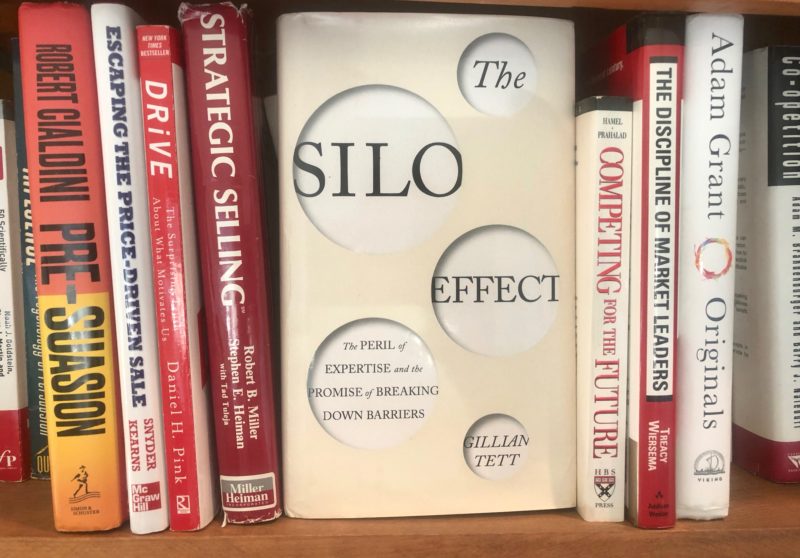
By Mark Boundy
Boundy’s Bookshelf: The Silo Effect. Are Your Sellers Siloed?
Boundy’s Bookshelf: The Silo Effect. Are Your Sellers Siloed? https://csuiteold.c-suitenetwork.com/advisors/wp-content/themes/csadvisore/images/empty/thumbnail.jpg 150 150 Mark Boundy https://secure.gravatar.com/avatar/fda1708afcd4681826f4fb12f56401d9?s=96&d=mm&r=g
I just finished reading The Silo Effect. The Peril of Expertise and the Promise of Breaking Down Barriers, a 2015 Book by Gillian Tett of The Financial Times. I recommend it to anyone in a business leadership position. For my own work with clients, I found Ms. Tett’s observations helped me clarify how important and valuable a company-wide focus on customer valuewill be to any company.
Most business people know that the word silo refers to “a system, process, department etc. which operates in isolation from others”. Organizations establish specialty sub-organizations while pursuing efficiency, manageability, and other worthwhile goals. The term silo tends to be used when dysfunctions arise: information hoarding, parochialism, competition for resources.
Silos sometimes contribute to more than mere aggravating dysfunction. According to the book, regulators over-compartmentalized in the early 2000s, causing them to fail to connect all the contributors to the 2008 financial meltdown.
Siloed Sellers.
For me, a seller is anyone who touches the customer. In many companies, this can include a wide variety of specialty roles:
- New customer sales
- Existing customer account management
- Sales engineering, technical sales
- Demonstration specialists
- Inside sales
- Bid/RFP services
- Customer service
- Technical Support
- Implementation/customer success
- Finance/accounts receivable/billing/credit
- Key account managers
- Channel management
- Marketing
- ..and more.
Forget all of the non-seller functions in your company: there are a lot of potential silos just among the roles that interact with customers. And that’s a problem.
Your customers hate your silos
We’ve all had frustrating experiences when each new person we talk to needs us to explain a full backstory…often made more frustrating when they don’t believe what their last co-worker told us. All of these experiences tell us why we shouldn’t inflict negative experiences on our customers.
Worse, avoiding negative experiences is setting the bar far too low. I advise that every seller (anyone who touches a customer) be equipped to talk to customers about their needs, problems, and aspirations. Better, your people should be able to uncover and develop value with a customer. Further, every seller role probably looks into your customer from a different angle; combining value insights into a single de-siloed view is something few great companies achieve.
De-siloing.
In The Silo Effect, Tett describes how data technology is coming of age to share information across silos. She also maintains (as do I) that such technology is valueless if there is not strong leadership and a vision that busts down silos. She shares stories of several organizations with strong leaders dedicated to silo-busting business models. It’s an interesting read (made even more interesting when you imagine what one of those companies learned about its blind spots in 2016, the year after the book was published…unending vigilance and a little healthy paranoia is the lesson, I think).
I love working with clients to unite every seller role around customer-perceived value. The key is finding the right leadership, and helping them operationalize the tools. Companies who pursue a corporate “culture of continuous value improvement” use technology and training to translate a customer value focus into a cohesive corporate culture. It’s probably not the only way to bust seller silos, but you seldom go wrong trying to deliver too much customer value.
If you’d like to discuss a more coordinated approach to your customers – say, the important ones you would hate to lose – reach me at mar@boundyconsulting.com. You can also comment below.
To your success!

